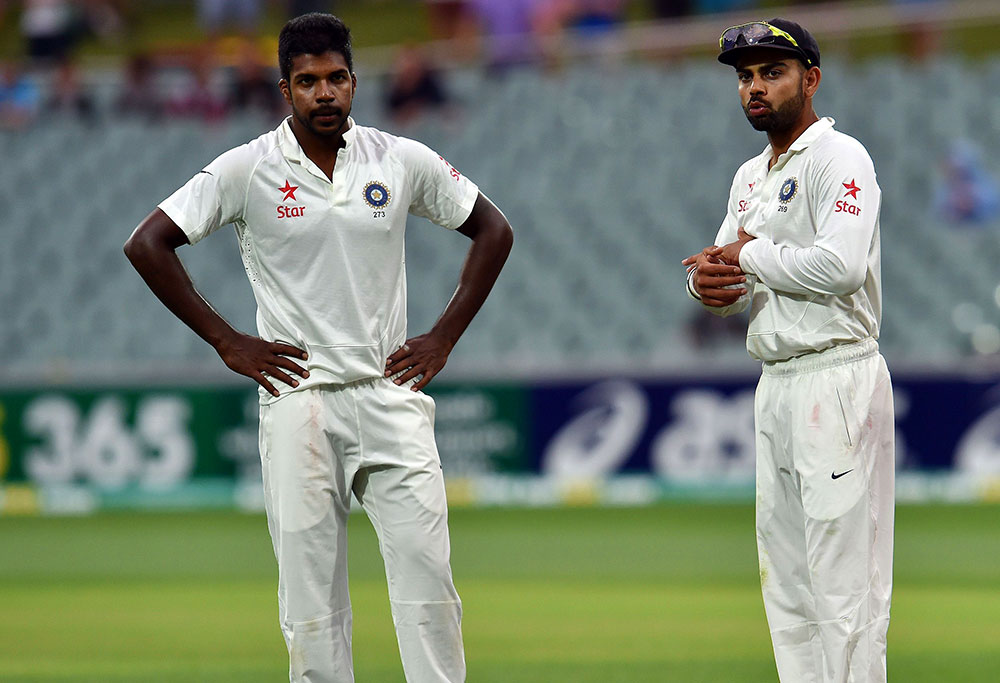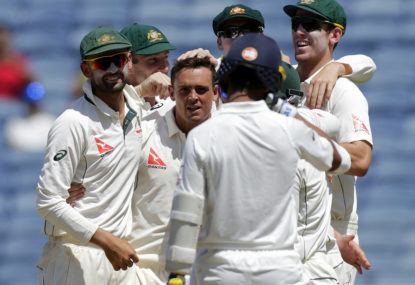Sixteen years ago this week Australia was celebrating a massive victory in India.
It was the opening Test of the 2001 series and the tourists had destroyed the home side by ten wickets inside three days at Mumbai.
All the wash-up from India vs Australia
» Match report
» Six talking points from the Test
» The Liebke ratings
» Australia embarrass India technically and mentally
» India buried in their own dustbowl
Talk of ending a 31-year series winning drought in India was rife.
Three weeks later that dream lay in tatters after India pulled off a miraculous victory in Kolkata and won a nail-biter in Chennai, to take the series 2-1.
Australia must ensure that history does not repeat itself in the coming month.
The win at Pune was a long time coming. In fact, according to skipper Steve Smith it was 4502 days between drinks.
As good as Australia was, India was woeful.
About the only thing Virat Kohli’s men could hang their hat on was the fact that their batting improved as the match unfolded – 105 in the first innings was followed by 107 in the second.
Australia not only beat India at its own game, it annihilated them to the tune of 333 runs.
The pitch was prepared to maximise one of India’s trumps and expose Australia’s soft underbelly in Asia.
The world’s top two bowlers, Ravichandran Ashwin and Ravindra Jadeja, were expected to run through the tourist’s spin averse batsmen.
Completely the opposite occurred.
After Mitchell Starc and Josh Hazlewood claimed the first three scalps in India’s first innings it was the spin combination of Steve O’Keefe (12-70) and Nathan Lyon (5-74) that claimed the remaining 17 wickets.

While O’Keefe took the honours, Lyon also bowled beautifully. The pair exploited the worn pitch exquisitely.
One of the knocks on O’Keefe during his career was his inability to gain much purchase off the pitch.
That was not the case on the Pune deck where he blended guile through the air with significant bite and bounce off the surface.
India’s batsmen gave the appearance of a collective who had not experienced such a surface before.
They seldom swept, were exposed when driving down the ground and played too often with hard hands in defence – all traits more expected from their Australian opponents.
India’s first innings lasted 40.1 overs, the second was terminated after 33.5.
Five of O’Keefe’s second innings scalps were as result of trapping indecisive batsmen plumb in front.
His other victim in the last innings of the match was Kohli, who inexplicably shouldered arms only to see the ball cannon into off-stump.
The Indian skipper stood motionless in bewilderment as to what had just happened.
His brain fade in the second innings came on the back of a loose shot outside off-stump to Starc in the first with the second ball he faced snaffled up by Peter Handscomb at first slip.
It was Kohli’s first duck in a Test match on home soil.
While he had a shocker, his counterpart flourished.
Smith’s effort in scoring a second innings century – his first in a Test in India – was aided by a good deal of inept fielding, having been dropped three times in reaching 37.
His innings lasted 202 balls, just one delivery shy of India’s entire second innings.
Even India’s use of the DRS proved a nightmare with both its referrals in the second innings needlessly burned in the space of five deliveries inside the first six overs.
Without doubt the biggest plus for the tourists was the performance of its spinners.
Many – including myself – felt our tweakers would lack penetration against men who were raised and skilled on spin friendly pitches.
Even the great Shane Warne found India tough going with his nine Tests netting 34 wickets at 43.1 and a strike rate of 81.
The pitch was so abrasive, Ashwin opened the bowling on the first morning but he and Jadeja struggled to have the impact of Lyon and O’Keefe.
Seldom has Ashwin gone for 4.2 runs per over in his storied career but he did in Australia’s second innings with figures of 4-119 off 28 overs.
India is now faced with a fascinating decision for the remainder of the series in respect to what kind of pitches it rolls out.

The recent 4-nil win over England was primarily played out on slow, low tracks that, while aiding the spinners, gave nothing like the advantages garnered from the Pune pitch.
Do India aim to replicate those strips on which it flourished in the England series or maintain surfaces akin to the one in the opening Test against at Pune?
Four of the five Tests in the England series produced first innings totals between 400 and 537 runs while on four occasions the second innings in those matches saw scores in the range of 417 and 759 runs.
Four of the five Tests in the England series went into the fifth day with the other concluded deep into the fourth. It was largely attritional cricket
Pune was never going to produce a match like that.
It is hard to imagine India putting in another performance of such ineptitude again in this series.
They will surely bite back hard.
There was much public debate about the eleven Australia went with for the opening encounter.
Almost certainly the same team will be trotted out at Bangalore for the second Test on Saturday.
While most things fell in favour of Smith’s team at Pune some of the same questions are present. Most revolve around the Marsh brothers.
Shaun contributed 16 and a 21-ball duck while Mitch scored four and 31.
The brevity of both India’s innings meant the younger Marsh did not visit the bowling crease.
India will be looking to keep both under pressure.
Currently, however, it is the entire Indian team that is under pressure.
It is not so much the fact that it lost its first home Test since December 2012 but the manner in which it did it.
Sixteen years ago, it was in a similar position and found a way out.
It must hope it can replicate that performance.
It is Australia’s job to ensure it does not.
While the opening encounter was a fascinating one, the sequels may be every bit as riveting.































































































